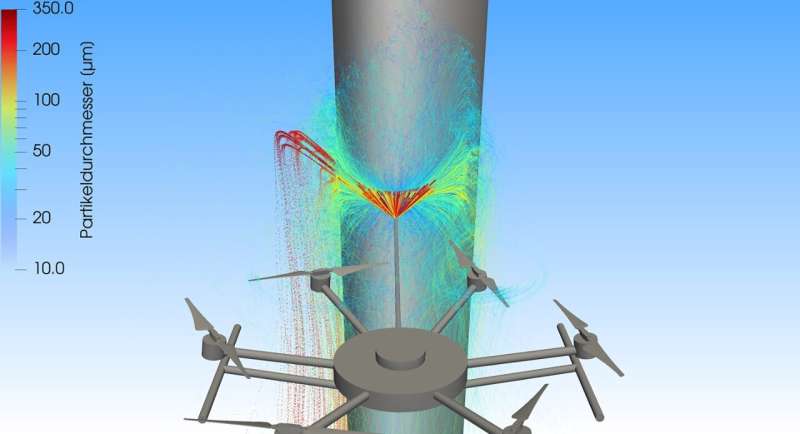This article has been reviewed according to Science X's editorial process and policies. Editors have highlighted the following attributes while ensuring the content's credibility:
fact-checked
trusted source
proofread
Using drones to protect wind turbines from ice

Damp, cold conditions are the enemy of wind power. If a layer of ice forms on the rotor blades, this can result in rotational imbalance and, hence, increased wear. In such cases, the turbines often have to be shut down for several days, leading to massive losses for the operators due to the pause in electricity production.
Now, for the first time, a Fraunhofer team has succeeded in using drones to protect rotor blades against ice. The new technique has been developed jointly by experts from the Fraunhofer Institute for Manufacturing Technology and Advanced Materials IFAM and the Fraunhofer Institute for Manufacturing Engineering and Automation IPA in the project "TURBO—Temporary coating by means of drones."
Up to now, operators who wanted to protect their wind turbines against ice had to dig deep into their pockets: Heating mats that can be integrated in the blades or systems to pump warm air into the rotors are extremely expensive—as is the use of helicopters to spray de-icing agent onto the turbines.
"Drones that are only used when needed offer a cost-effective alternative," says Andreas Stake, project manager at Fraunhofer IFAM. However, in order to use drones to prevent ice, a number of conditions have to be met: As well as being environmentally friendly, the coating materials need to demonstrate good adhesion and sufficient durability so they remain on the rotors for weeks and protect them from ice. The spraying system used needs to be highly accurate but lightweight at the same time. And finally, the drones need to have a high payload and allow for very precise control.
Important for wind turbines: Environmentally friendly materials and precise application equipment
The Fraunhofer researchers working on the TURBO project succeeded in developing a prototype which fulfills all of these requirements: The coating material designed by the scientists at Fraunhofer IFAM in Bremen is made from urea and wax, is environmentally friendly and demonstrates good adhesion. This material can be applied quickly and easily using a spray technique and also dries quickly. The coating underwent testing in an ice chamber at the institute to confirm that it reliably protects against the formation of frost.
The team at Fraunhofer IPA built the equipment used to apply the coating. It consists of a small pump which presses the fluid urea/wax mixture at high pressure into a long, thin lance, at the tip of which is a nozzle with a diameter of just 0.3 millimeters. This airless pump system is able to produce droplets with a diameter of 100 micrometers. Even at wind speeds of 35 kilometers per hour, these droplets can still be sprayed precisely onto the edges of the rotor blades where they then solidify. The edges are particularly important as this is where the icing process starts when wet, cold air hits the turbine.
Ensuring success with simulations
Dr. Oliver Tiedje, project manager at Fraunhofer IPA, and his team determined the technical parameters—for example, the required pressure, an efficient atomization method and the optimum droplet size—using fluid dynamic simulations. "Our decades of experience in modeling coating processes really helped us out. We were able to draw on this expertise," says the physicist. "However, we did have to adapt the process parameters to the complex geometry of the wind turbines."
The researchers now intend to work with industry partners to develop the technique further and get it ready for series production. There are numerous applications in which drones can be used to apply coatings, ranging from ice protection for wind turbines and overhead lines in rail transport to building refurbishment—for example, repairing defects in render on parts of buildings that are difficult to reach.
The "TURBO: Temporary coating by means of drones—Icing protection of wind turbines as a case study" project was supported by 19 companies including coating and raw material manufacturers, manufacturers of coating equipment and drones, and operators of wind turbines.
















